Long-Term Simulated Direct N2O Emissions from German Oilseed Rape Cultivation below the IPCC Emission Factor
Abstract
:1. Introduction
2. Materials and Methods
2.1. Experimental Sites and Field Trials
2.2. Field Data Collection
2.3. Model Description
2.3.1. Structure of the N2O Model Component
2.3.2. Model Initialization and Parametrization
2.3.3. Model Calibration and Evaluation
2.4. Long-Term Simulations
2.5. N-Input Sensitivity Analysis and Emission-Factor Calculation
3. Results
3.1. Dynamics of Daily N2O Fluxes
3.2. Cumulative N2O Emissions
3.3. Long-Term Simulated Mean Annual Emissions
3.4. Fertilizer Related Emission Factors
4. Discussion
4.1. Driving Forces of N2O Flux Dynamics
4.2. Source Paths of N2O Emissions
4.3. Model Purpose and Level of Aggregation
4.4. Nitrogen Input Related Emission Factors
5. Conclusions
Supplementary Materials
Author Contributions
Funding
Data Availability Statement
Acknowledgments
Conflicts of Interest
Appendix A
- Additional Formulas during Nitrification Processes
- Additional Formulas during Denitrification Processes
| Parameter | Unit | Value | Source/Fitting |
|---|---|---|---|
| CNDPM | - | 6 | [39] |
| CNRPM | - | 150 | assumption |
| CNBIOM | - | 8 | [39] |
| CNSOM | - | 10 | [39] |
| - | 0.4 | [39] | |
| - | 0.3 | ||
| . | - | 1 | |
| . | - | 0.2 | |
| day−1 | 0.07 | [34] | |
| day−1 | 0.007 | ||
| day−1 | 0.01 | ||
| day−1 | Berge: 0.00037 | fitted to SMNmeasured | |
| Dedelow: 0.00090 | |||
| Hohenschulen: 0.00037 | |||
| Ihinger Hof: 0.00050 | |||
| Merbitz: 0.00055 | |||
| Mineff | - | Berge: 1.0 | fitted to SMNmeasured |
| Dedelow: 1.5 | |||
| Hohenschulen: 1.0 | |||
| Ihinger Hof: 1.0 | |||
| Merbitz: 1.5 | |||
| fr_n-loss | - | 0.0157 | |
| knit | day−1 | 0.18 | fitted to NH4-Nmeasured |
| kden | day−1 | 1.9 | fitted to N2Omeasured |
| Km | - | 26 | [36] |
| WFPScrit_den | [%] | Berge: 0.90 | fitted to N2O measured |
| Dedelow: 0.85 | |||
| Hohenschulen: 0.80 | |||
| Ihinger Hof: 0.95 | |||
| Merbitz: 0.87 |
| Site | x = Mineral N input [kg N ha−1] y = N2O Emission [kg N2O-N ha−1] | R2 |
|---|---|---|
| Berge | y = 1.163·10−6 x2 + 1.465·10−3 x − 9.575·10−3 | 0.90 |
| Dedelow | y = 1.343·10−6 x2 + 1.397·10−3 x − 1.033·10−2 | 0.87 |
| Hohenschulen | y = 3.687·10−6 x2 + 1.083·10−3 x + 4.036·10−3 | 0.82 |
| Ihinger Hof | y = 6.076·10−6 x2 + 1.952·10−3 x + 8.347·10−3 | 0.84 |
| Merbitz | y = 2.876·10−5 x2 + 9.143·10−4 x − 3.647·10−2 | 0.61 |
| Site | Nopt [kg N ha−1] | YNopt [t ha−1] |
|---|---|---|
| Berge | 191 | 3.62 |
| Dedelow | 196 | 3.92 |
| Hohenschulen | 222 | 4.54 |
| Ihinger Hof | 222 | 4.21 |
| Merbitz | 201 | 4.33 |
References
- IPCC. AR6 WG1; IPCC: Geneva, Switzerland, 2021. [Google Scholar]
- Tian, H.; Xu, R.; Canadell, J.G.; Thompson, R.L.; Winiwarter, W.; Suntharalingam, P.; Davidson, E.A.; Ciais, P.; Jackson, R.B.; Janssens-maenhout, G.; et al. A comprehensive quantification of global nitrous oxide sources and sinks. Nature 2020, 586, 248–256. [Google Scholar] [CrossRef]
- Conrad, R. Soil microorganisms as controllers of atmospheric trace gases (H2, CO, CH4, OCS, N2O, and NO). Microbiol. Rev. 1996, 60, 609–640. [Google Scholar] [CrossRef]
- Köster, J.R.; Cárdenas, L.; Senbayram, M.; Bol, R.; Well, R.; Butler, M.; Mühling, K.H.; Dittert, K. Rapid shift from denitrification to nitrification in soil after biogas residue application as indicated by nitrous oxide isotopomers. Soil Biol. Biochem. 2011, 43, 1671–1677. [Google Scholar] [CrossRef]
- Signor, D.; Cerri, C.E.D. Nitrous oxide emissions in agricultural soils: A review. Pesqui. Agropecuária Trop. 2013, 43, 322–338. [Google Scholar] [CrossRef]
- Prosser, J.I. NITROGEN IN SOILS|Nitrification. In Encyclopedia of Soils in the Environment; Elsevier: Amsterdam, The Netherlands, 2005; pp. 31–39. ISBN 9780123485304. [Google Scholar]
- Butterbach-Bahl, K.; Baggs, E.M.; Dannenmann, M.; Kiese, R.; Zechmeister-Boltenstern, S. Nitrous oxide emissions from soils: How well do we understand the processes and their controls? Phil. Trans. R. Soc. B 2013, 368, 20130122. [Google Scholar] [CrossRef]
- Hénault, C.; Germon, J.C. NEMIS, a predictive model of denitrification on the field scale. Eur. J. Soil Sci. 2000, 51, 257–270. [Google Scholar] [CrossRef]
- Weier, K.L.; Doran, J.W.; Power, J.F.; Walters, D.T. Denitrification and the Dinitrogen/Nitrous Oxide Ratio as Affected by Soil Water, Available Carbon, and Nitrate. Soil Sci. Soc. Am. J. 1993, 57, 66–72. [Google Scholar] [CrossRef]
- Chen, C.; Chen, D.; Pan, J.; Lam, S.K. Analysis of factors controlling soil N2O emission by principal component and path analysis method. Environ. Earth Sci. 2014, 72, 1511–1517. [Google Scholar] [CrossRef]
- Zumft, W.G. Cell biology and molecular basis of denitrification. Microbiol. Mol. Biol. Rev. 1997, 61, 533–616. [Google Scholar] [CrossRef]
- Ruser, R.; Flessa, H.; Russow, R.; Schmidt, G.; Buegger, F.; Munch, J.C. Emission of N2O, N2 and CO2 from soil fertilized with nitrate: Effect of compaction, soil moisture and rewetting. Soil Biol. Biochem. 2006, 38, 263–274. [Google Scholar] [CrossRef]
- Mosier, A.R.; Doran, J.W.; Freney, J.R. Managing soil denitrification. J. Soil Water Conserv. 2002, 57, 505–512. [Google Scholar]
- Rochette, P.; Eriksen-Hamel, N.S. Chamber Measurements of Soil Nitrous Oxide Flux: Are Absolute Values Reliable? Soil Sci. Soc. Am. J. 2008, 72, 331–342. [Google Scholar] [CrossRef]
- Li, Y.; Barton, L.; Chen, D. Simulating response of N2O emissions to fertiliser N application and climatic variability from a rain-fed and wheat-cropped soil in Western Australia. J. Sci. Food Agric. 2012, 92, 1130–1143. [Google Scholar] [CrossRef]
- Goglio, P.; Colnenne-David, C.; Laville, P.; Doré, T.; Gabrielle, B. 29% N2O emission reduction from a modelled low-greenhouse gas cropping system during 2009–2011. Environ. Chem. Lett. 2013, 11, 143–149. [Google Scholar] [CrossRef]
- Parton, W.J.; Mosier, A.R.; Ojima, D.S.; Valentine, D.W.; Schimel, D.S.; Weier, K.; Kulmala, A.E. Generalized model for N2 and N2O production from nitrification and denitrification. Glob. Biogeochem. Cycles 1996, 10, 401–412. [Google Scholar] [CrossRef]
- IPCC. Chapter 11: N2O emissions from managed soils, and CO2 emissions from lime and urea application. In IPCC Guidelines for National Greenhouse Gas Inventories; IPCC: Geneva, Switzerland, 2006; pp. 11.1–11.54. [Google Scholar]
- IPCC. N2O Emissions from Managed Soils, and CO2 Emissions from Lime and Urea Application. In 2019 Refinement to the 2006 IPCC Guidelines for National Greenhouse Gas Inventories; IPCC: Geneva, Switzerland, 2019; pp. 1–48. ISBN 4887880324. [Google Scholar]
- Shcherbak, I.; Millar, N.; Robertson, G.P. Global metaanalysis of the nonlinear response of soil nitrous oxide (N2O) emissions to fertilizer nitrogen. Proc. Natl. Acad. Sci. USA 2014, 111, 9199–9204. [Google Scholar] [CrossRef]
- Leip, A.; Busto, M.; Winiwarter, W. Developing spatially stratified N2O emission factors for Europe. Environ. Pollut. 2011, 159, 3223–3232. [Google Scholar] [CrossRef]
- Ruser, R.; Fuß, R.; Andres, M.; Hegewald, H.; Kesenheimer, K.; Köbke, S.; Räbiger, T.; Quinones, T.S.; Augustin, J.; Christen, O.; et al. Nitrous oxide emissions from winter oilseed rape cultivation. Agric. Ecosyst. Environ. 2017, 249, 57–69. [Google Scholar] [CrossRef]
- Mathivanan, G.P.; Eysholdt, M.; Zinnbauer, M.; Rösemann, C.; Fuß, R. New N2O emission factors for crop residues and fertiliser inputs to agricultural soils in Germany. Agric. Ecosyst. Environ. 2021, 322, 107640. [Google Scholar] [CrossRef]
- Heinen, M. Simplified denitrification models: Overview and properties. Geoderma 2005, 133, 444–463. [Google Scholar] [CrossRef]
- DESTATIS Regional Database Germany Verfügbar Unter. Available online: https://www.regionalstatistik.de/genesis/online (accessed on 21 November 2023).
- Fuss, R.; Hueppi, R.; Pedersen, A.R. Package ‘Gasfluxes’. 2019. Available online: https://cran.r-project.org/web/packages/gasfluxes/gasfluxes.pdf (accessed on 29 November 2023).
- Räbiger, T.; Andres, M.; Hegewald, H.; Kesenheimer, K.; Köbke, S.; Quinones, T.S.; Böttcher, U.; Kage, H. Indirect nitrous oxide emissions from oilseed rape cropping systems by NH3 volatilization and nitrate leaching as affected by nitrogen source, N rate and site conditions. Eur. J. Agron. 2020, 116, 126039. [Google Scholar] [CrossRef]
- Böttcher, U.; Weymann, W.; Pullens, J.W.M.; Olesen, J.E.; Kage, H. Development and evaluation of HUME-OSR: A dynamic crop growth model for winter oilseed rape. Field Crops Res. 2020, 246, 107679. [Google Scholar] [CrossRef]
- Weymann, W. Model-Base Analysis of Weather, Soil and Management Effects on Yield Formation of Winter Oilseed Rape; Christian-Albrechts-Universität zu Kiel: Kiel, Germany, 2015. [Google Scholar]
- Ratjen, A.M.; Kage, H. Forecasting yield via reference- and scenario calculations. Comput. Electron. Agric. 2015, 114, 212–220. [Google Scholar] [CrossRef]
- Kage, H.; Stützel, H. HUME: An object oriented component library for generic modular modelling of dynamic systems. Model. Crop. Syst. 1999, 2–3. [Google Scholar]
- Kage, H.; Alt, C.; Stützel, H. Aspects of nitrogen use efficiency of cauliflower I. A simulation modelling based analysis of nitrogen availability under field conditions. J. Agric. Sci. 2003, 141, 1–16. [Google Scholar] [CrossRef]
- Zhou, Z.; Zheng, X.; Xie, B.; Han, S.; Liu, C. A process-based model of N2O emission from a rice-winter wheat rotation agro-ecosystem: Structure, validation and sensitivity. Adv. Atmos. Sci. 2010, 27, 137–150. [Google Scholar] [CrossRef]
- Hansen, S.; Jensen, H.; NE, N.; Svendsen, H. NPo-Research, A10: DAISY: Soil Plant Atmosphere System Model; Miljoestyrelsen: Copenhagen, Denmark, 1990. [Google Scholar]
- Thorburn, P.J.; Biggs, J.S.; Collins, K.; Probert, M.E. Using the APSIM model to estimate nitrous oxide emissions from diverse Australian sugarcane production systems. Agric. Ecosyst. Environ. 2010, 136, 343–350. [Google Scholar] [CrossRef]
- Del Grosso, S.J.; Parton, W.J.; Mosier, A.R.; Ojima, D.S.; Kulmala, A.E.; Phongpan, S. General model for N2O and N2 gas emissions from soils due to dentrification. Global Biogeochem. Cycles 2000, 14, 1045–1060. [Google Scholar] [CrossRef]
- van Genuchten, M.T. A Closed-form Equation for Predicting the Hydraulic Conductivity of Unsaturated Soils. Soil Sci. Soc. Am. J. 1980, 44, 892–898. [Google Scholar] [CrossRef]
- Henke, J.; Böttcher, U.; Neukam, D.; Sieling, K.; Kage, H. Evaluation of different agronomic strategies to reduce nitrate leaching after winter oilseed rape (Brassica napus L.) using a simulation model. Nutr. Cycl. Agroecosyst. 2008, 82, 299–314. [Google Scholar] [CrossRef]
- Verberne, E.L.J.; Hassink, J.; de Willigen, P.; Groot, J.J.R.; van Veen, J.A. Modelling organic matter dynamics in different soils. Neth. J. Agric. Sci. 1990, 38, 221–238. [Google Scholar] [CrossRef]
- R Core Team. R: A Language and Environment for Statistical Computing R. Foundation for Statistical Computing; Version 4.1.2; R Core Team: Vienna, Austria, 2021. [Google Scholar]
- Neeteson, J.J.; Wadman, W.P. Assessment of economically optimum application rates of fertilizer N on the basis of response curves. Fertil. Res. 1987, 12, 37–52. [Google Scholar] [CrossRef]
- Dhakal, C.; Lange, K. Crop yield response functions in nutrient application: A review. Agron. J. 2021, 113, 5222–5234. [Google Scholar] [CrossRef]
- Gabrielle, B.; Laville, P.; Duval, O.; Nicoullaud, B.; Germon, J.C.; Hénault, C. Process-based modeling of nitrous oxide emissions from wheat-cropped soils at the subregional scale. Global Biogeochem. Cycles 2006, 20, GB4018. [Google Scholar] [CrossRef]
- Yuan, F.; Meixner, T.; Fenn, M.E.; Šimůnek, J. Impact of transient soil water simulation to estimated nitrogen leaching and emission at high- and low-deposition forest sites in Southern California. J. Geophys. Res. 2011, 116, G03040. [Google Scholar] [CrossRef]
- Cui, J.; Li, C.; Sun, G.; Trettin, C. Linkage of MIKE SHE to Wetland-DNDC for carbon budgeting and anaerobic biogeochemistry simulation. Biogeochemistry 2005, 72, 147–167. [Google Scholar] [CrossRef]
- Myrgiotis, V.; Williams, M.; Rees, R.M.; Topp, C.F.E. Estimating the soil N2O emission intensity of croplands in northwest Europe. Biogeosciences 2019, 16, 1641–1655. [Google Scholar] [CrossRef]
- Li, X.; Yeluripati, J.; Jones, E.O.; Uchida, Y.; Hatano, R. Hierarchical Bayesian calibration of nitrous oxide (N2O) and nitrogen monoxide (NO) flux module of an agro-ecosystem model: ECOSSE. Ecol. Modell. 2015, 316, 14–27. [Google Scholar] [CrossRef]
- Smith, W.; Grant, B.; Qi, Z.; He, W.; VanderZaag, A.; Drury, C.F.; Helmers, M. Development of the DNDC model to improve soil hydrology and incorporate mechanistic tile drainage: A comparative analysis with RZWQM2. Environ. Model. Softw. 2020, 123, 104577. [Google Scholar] [CrossRef]
- Mielenz, H.; Thorburn, P.J.; Scheer, C.; De Antoni Migliorati, M.; Grace, P.R.; Bell, M.J. Opportunities for mitigating nitrous oxide emissions in subtropical cereal and fiber cropping systems: A simulation study. Agric. Ecosyst. Environ. 2016, 218, 11–27. [Google Scholar] [CrossRef]
- Guest, G.; Kröbel, R.; Grant, B.; Smith, W.; Sansoulet, J.; Pattey, E.; Desjardins, R.; Jégo, G.; Tremblay, N.; Tremblay, G. Model comparison of soil processes in eastern Canada using DayCent, DNDC and STICS. Nutr. Cycl. Agroecosyst. 2017, 109, 211–232. [Google Scholar] [CrossRef]
- Groffman, P.M.; Tiedje, J.M. Relationships between denitrification, CO2 production and air-filled porosity in soils of different texture and drainage. Soil Biol. Biochem. 1991, 23, 299–302. [Google Scholar] [CrossRef]
- Velthof, G.L.; Kuikman, P.J.; Oenema, O. Nitrous oxide emission from animal manures applied to soil under controlled conditions. Biol. Fertil. Soils 2003, 37, 221–230. [Google Scholar] [CrossRef]
- Chadwick, D.R.; Pain, B.F.; Brookman, S.K.E. Nitrous Oxide and Methane Emissions following Application of Animal Manures to Grassland. J. Environ. Qual. 2000, 29, 277–287. [Google Scholar] [CrossRef]
- Li, C.; Aber, J.; Stange, F.; Butterbach-Bahl, K.; Papen, H. A process-oriented model of N2O and NO emissions from forest soils: 1. Model development. J. Geophys. Res. Atmos. 2000, 105, 4369–4384. [Google Scholar] [CrossRef]
- Yang, Q.; Zhang, X.; Abraha, M.; Del grosso, S.; Robertson, G.P.; Chen, J. Enhancing the soil and water assessment tool model for simulating N2O emissions of three agricultural systems. Ecosyst. Health Sustain. 2017, 3, 11879067. [Google Scholar] [CrossRef]
- Bell, M.J.; Jones, E.; Smith, J.; Smith, P.; Yeluripati, J.; Augustin, J.; Juszczak, R.; Olejnik, J.; Sommer, M. Simulation of soil nitrogen, nitrous oxide emissions and mitigation scenarios at 3 European cropland sites using the ECOSSE model. Nutr. Cycl. Agroecosyst. 2012, 92, 161–181. [Google Scholar] [CrossRef]
- Molina-Herrera, S.; Haas, E.; Klatt, S.; Kraus, D.; Augustin, J.; Magliulo, V.; Tallec, T.; Ceschia, E.; Ammann, C.; Loubet, B.; et al. A modeling study on mitigation of N2O emissions and NO3 leaching at different agricultural sites across Europe using LandscapeDNDC. Sci. Total Environ. 2016, 553, 128–140. [Google Scholar] [CrossRef]
- Kim, D.G.; Hernandez-Ramirez, G.; Giltrap, D. Linear and nonlinear dependency of direct nitrous oxide emissions on fertilizer nitrogen input: A meta-analysis. Agric. Ecosyst. Environ. 2013, 168, 53–65. [Google Scholar] [CrossRef]
- Walter, K.; Don, A.; Fuß, R.; Kern, J.; Drewer, J.; Flessa, H. Direct nitrous oxide emissions from oilseed rape cropping—A meta-analysis. GCB Bioenergy 2015, 7, 1260–1271. [Google Scholar] [CrossRef]
- Mallast, J.; Stichnothe, H.; Flessa, H.; Fuß, R.; Lucas-Moffat, A.M.; Petersen-Schlapkohl, U.; Augustin, J.; Hagemann, U.; Kesenheimer, K.; Ruser, R.; et al. Multi-variable experimental data set of agronomic data and gaseous soil emissions from maize, oilseed rape and other energy crops at eight sites in Germany. Open Data J. Agric. Res. 2021, 7, 11–19. [Google Scholar] [CrossRef]
- Kristensen, A.H.; Thorbjørn, A.; Jensen, M.P.; Pedersen, M. Gas-phase diffusivity and tortuosity of structured soils. J. Contam. Hydrol. 2010, 115, 26–33. [Google Scholar] [CrossRef] [PubMed]
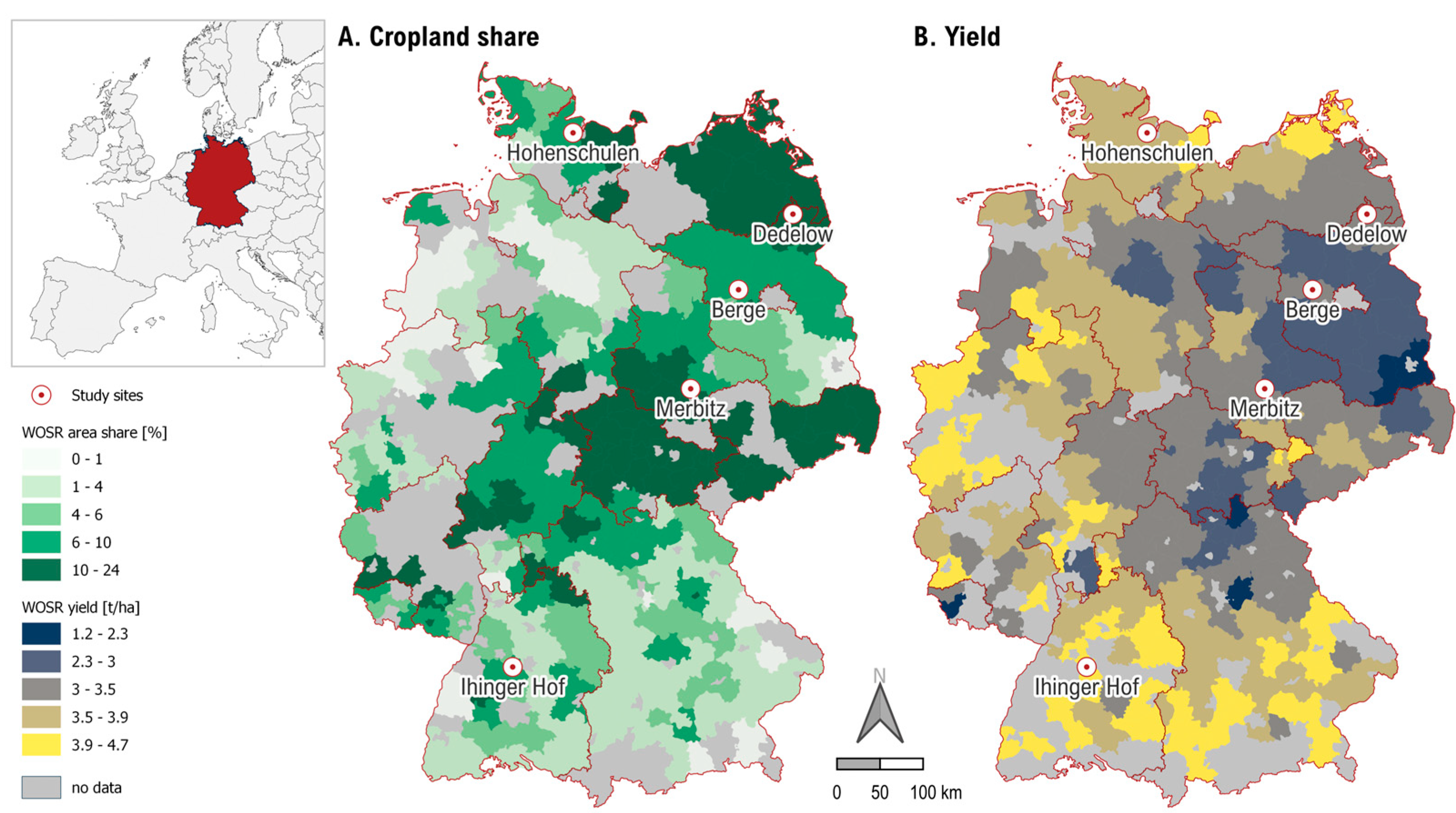
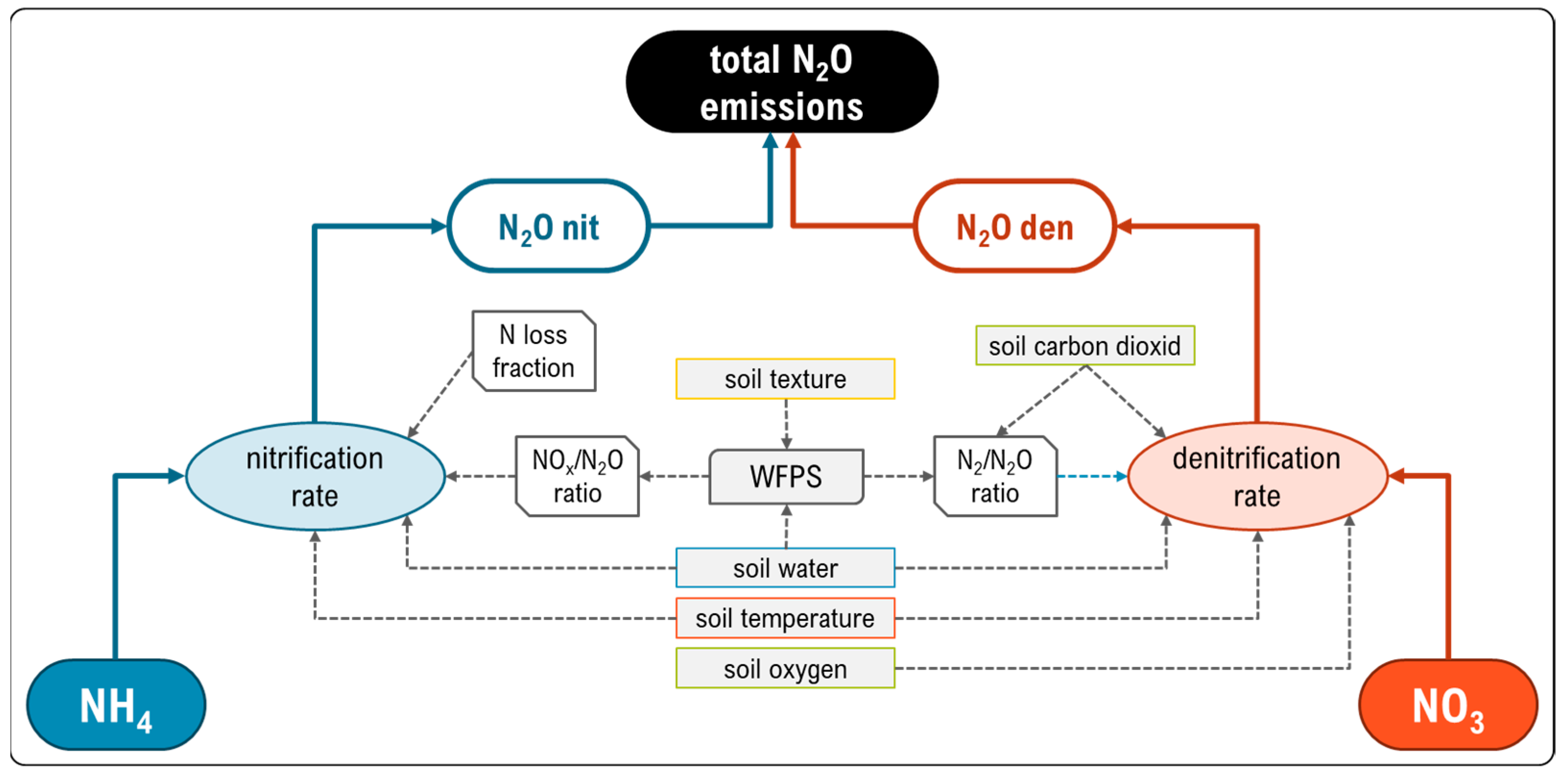

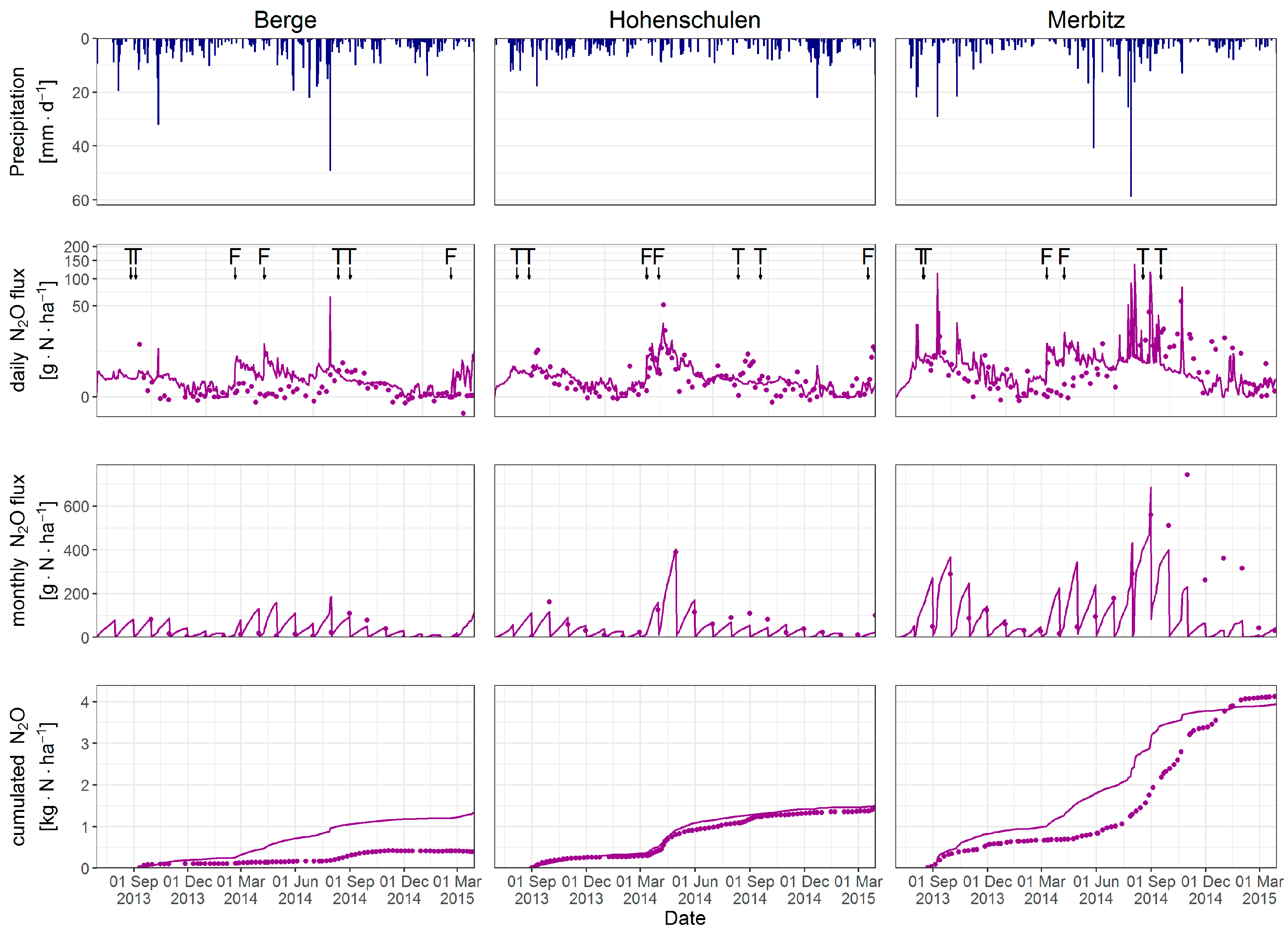
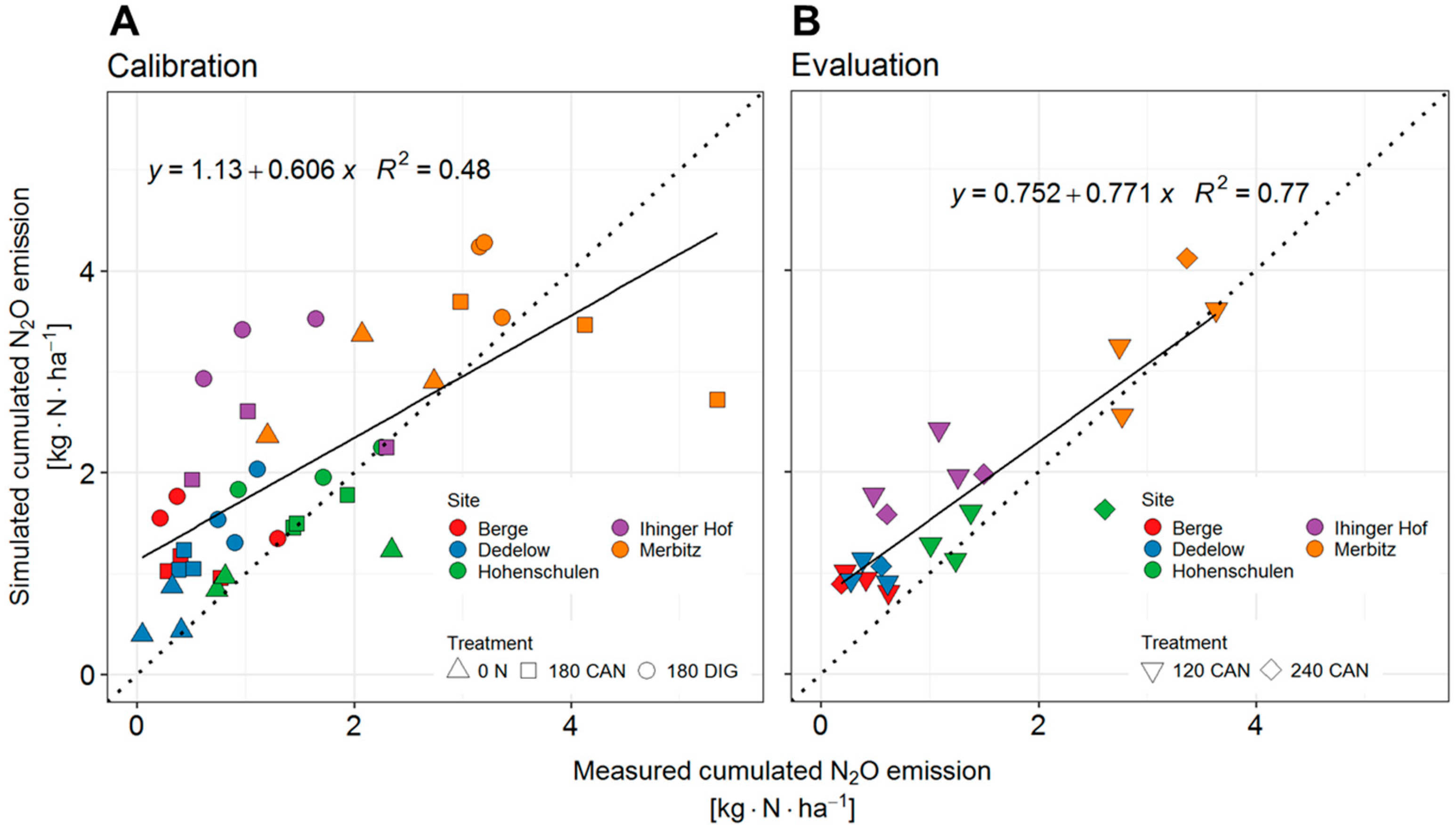
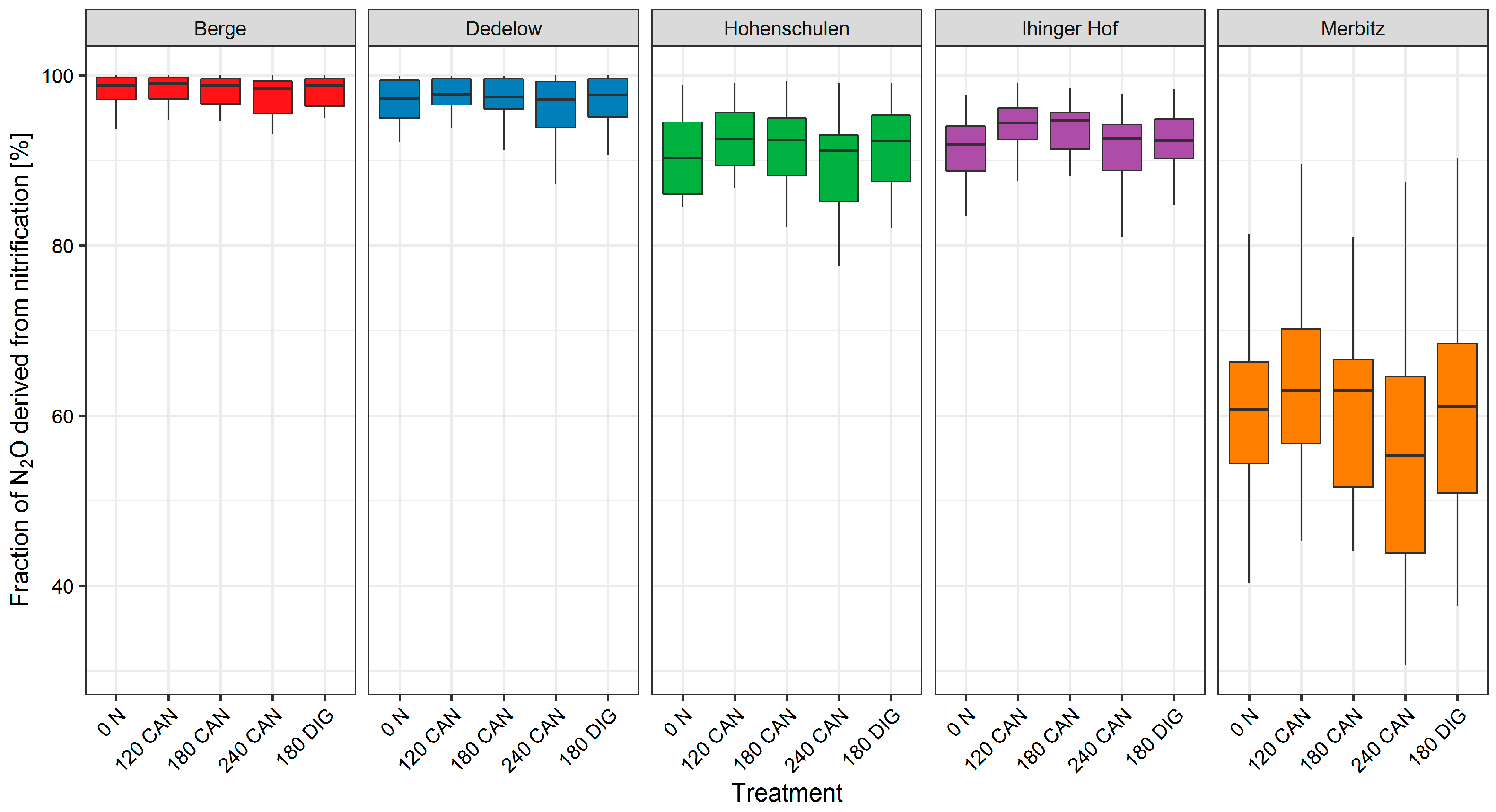
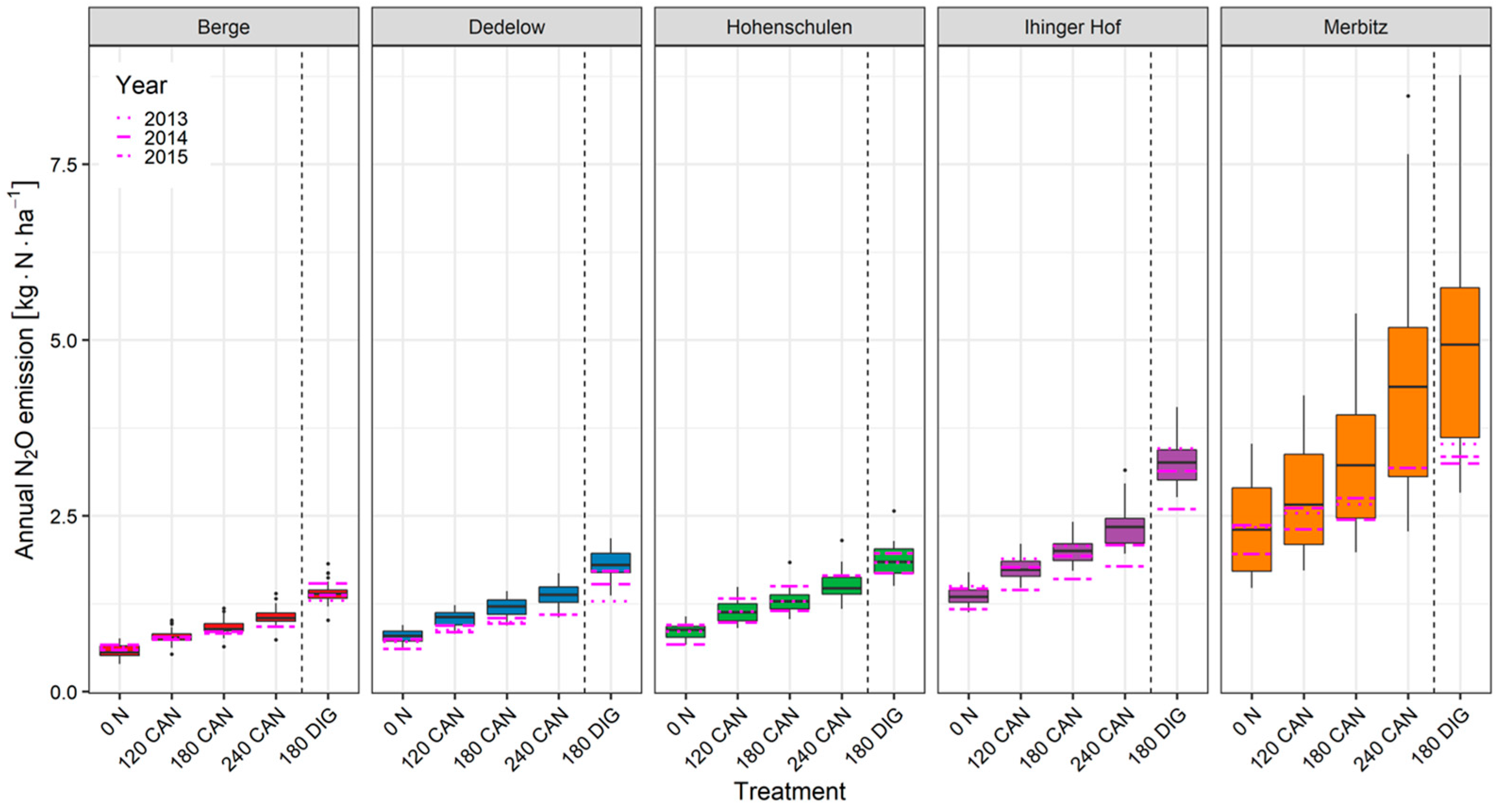
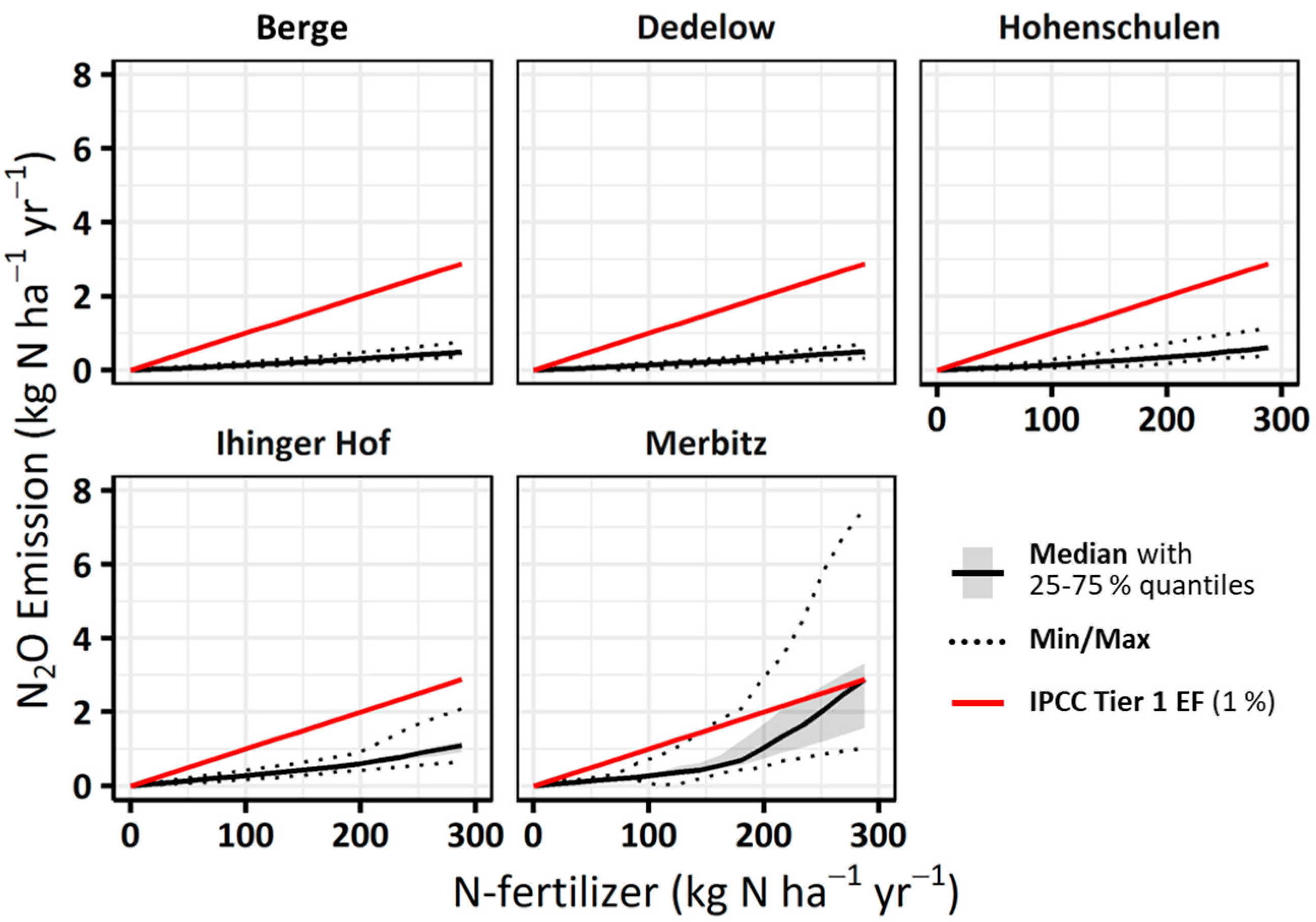
| Site | Soil Type [IUSS] | Clay [%] | Silt [%] | Sand [%] | Texture Class [IUSS] | pH | Corg [%) | Nt [%) |
|---|---|---|---|---|---|---|---|---|
| Berge | Luvisol | 9.3 | 18.5 | 72.2 | SaLo | 6.5 | 1.15 | 0.09 |
| Dedelow | Luvisol | 10 | 30.9 | 59.1 | Lo | 7.4 | 0.75 | 0.10 |
| Hohenschulen | Haplic Luvisol | 10.5 | 29.4 | 60.1 | Lo | 6.0 | 1.68 | 0.20 |
| Ihinger Hof | Haplic Luvisol/Anthrosol | 3.2 | 78.2 | 18.6 | SiLo | 6.8 | 1.87 | 0.12 |
| Merbitz | Haplic Chernosem | 15.8 | 67.8 | 16.4 | SiClLo | 6.6 | 1.18 | 0.11 |
| Site | Temperature | Precipitation | ||||||
|---|---|---|---|---|---|---|---|---|
| [°C] | Yearly Deviation [°C] | [mm] | Yearly Deviation [mm] | |||||
| LTA | 2013 | 2014 | 2015 | LTA | 2013 | 2014 | 2015 | |
| Berge | 8.7 | +0.7 | +4.3 | +1.9 | 503 | +112 | −21 | +67 |
| Dedelow | 8.4 | +0.3 | +1.5 | +1.3 | 485 | −39 | +76 | −71 |
| Hohenschulen | 8.9 | −0.8 | +0.8 | −0.1 | 732 | −78 | −323 | +38 |
| Ihinger Hof | 8.3 | +0.4 | +2.2 | +1.8 | 688 | +235 | +75 | −144 |
| Merbitz | 9.0 | +0.1 | +1.7 | +1.4 | 520 | +180 | −64 | −91 |
| Dataset | Calibration | Evaluation | ||||
|---|---|---|---|---|---|---|
| Aggregation level | total | monthly | daily | total | monthly | daily |
| No. of observations | 39 | 604 | 2228 | 21 | 304 | 1144 |
| R2 | 0.48 | 0.23 | 0.065 | 0.77 | 0.34 | 0.064 |
| Slope | 0.606 | 0.41 | 0.16 | 0.771 | 0.53 | 0.12 |
| Intercept | −1.13 | 0.09 | 0.004 | 0.752 | 0.07 | 0.004 |
| RMSE [kg N ha−1] | 1.05 | 0.17 | 0.01 | 0.69 | 0.13 | 0.01 |
| Site | EF200 [%] | EFNopt [%] | EF180 DIG [%] |
|---|---|---|---|
| Berge | 0.165 | 0.164 | 0.462 |
| Dedelow | 0.161 | 0.161 | 0.579 |
| Hohenschulen | 0.184 | 0.192 | 0.542 |
| Ihinger Hof | 0.321 | 0.334 | 1.050 |
| Merbitz | 0.648 | 0.651 | 1.419 |
Disclaimer/Publisher’s Note: The statements, opinions and data contained in all publications are solely those of the individual author(s) and contributor(s) and not of MDPI and/or the editor(s). MDPI and/or the editor(s) disclaim responsibility for any injury to people or property resulting from any ideas, methods, instructions or products referred to in the content. |
© 2023 by the authors. Licensee MDPI, Basel, Switzerland. This article is an open access article distributed under the terms and conditions of the Creative Commons Attribution (CC BY) license (https://creativecommons.org/licenses/by/4.0/).
Share and Cite
Räbiger, T.; Neukam, D.; Knieß, A.; Böttcher, U.; Kage, H.; Kühling, I. Long-Term Simulated Direct N2O Emissions from German Oilseed Rape Cultivation below the IPCC Emission Factor. Agriculture 2024, 14, 70. https://doi.org/10.3390/agriculture14010070
Räbiger T, Neukam D, Knieß A, Böttcher U, Kage H, Kühling I. Long-Term Simulated Direct N2O Emissions from German Oilseed Rape Cultivation below the IPCC Emission Factor. Agriculture. 2024; 14(1):70. https://doi.org/10.3390/agriculture14010070
Chicago/Turabian StyleRäbiger, Thomas, Dorothee Neukam, Astrid Knieß, Ulf Böttcher, Henning Kage, and Insa Kühling. 2024. "Long-Term Simulated Direct N2O Emissions from German Oilseed Rape Cultivation below the IPCC Emission Factor" Agriculture 14, no. 1: 70. https://doi.org/10.3390/agriculture14010070
APA StyleRäbiger, T., Neukam, D., Knieß, A., Böttcher, U., Kage, H., & Kühling, I. (2024). Long-Term Simulated Direct N2O Emissions from German Oilseed Rape Cultivation below the IPCC Emission Factor. Agriculture, 14(1), 70. https://doi.org/10.3390/agriculture14010070






